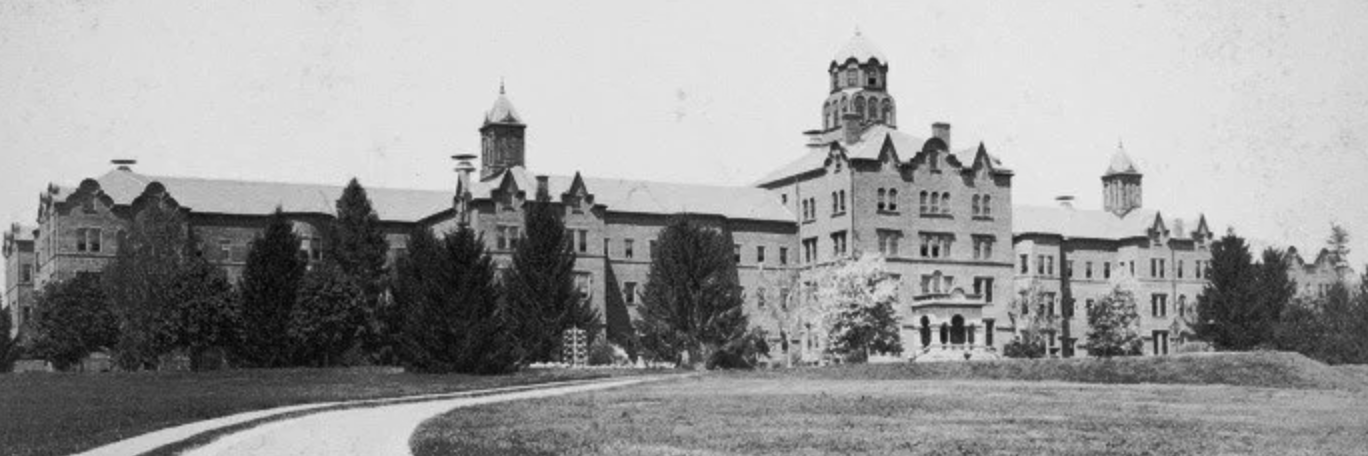Introduction:
First opening its doors in 1858, “The Northampton Lunatic Hospital” was designed as a cutting-edge mental health care facility carefully constructed to combat the mass incarceration of neuro-divergent individuals. Based on the teaching of activist Dorothea Lynde Dix (1802-1887) and the philosophies of physician Phillipe Pinel (1754-1826), the hospital implemented a health treatment system known as “moral treatment.”[1] Patients who were found “unsound” or mentally ill were recommended for regiments of psychiatric treatment within mental hospitals. Patient’s treatment regiments and stay at the hospital were originally intended for short periods of time in order for them to regain their health.[2] They were expected to receive new methods of health treatment developed within the bourgeoning field of psychology while enjoying the fresh air of the Western Massachusetts countryside and the luxurious accommodations of the large Kirkbride style buildings.[3]
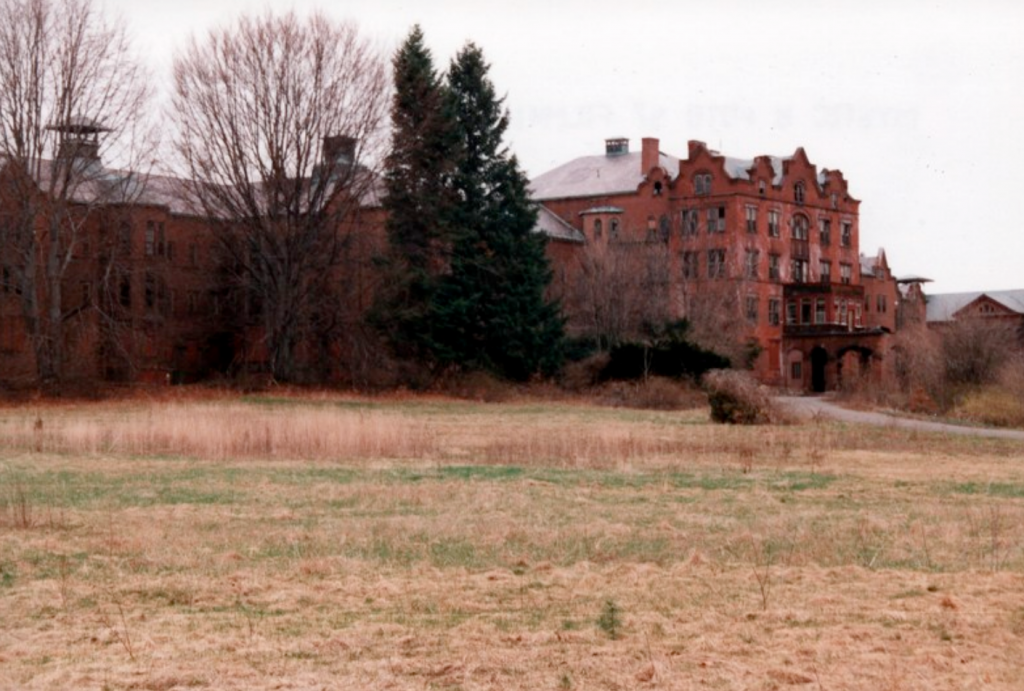
Northampton State Hospital’s “Old Main” building from the South Lawn, May 1999. Courtesy of Tom Riddell.
Constructed as the third state institution for the insane in the state of Massachusetts, “The Northampton Lunatic Hospital” eventually becoming the Northampton State Hospital, was revered as a source of pride within the community of Northampton. In the late 18th-century and early 19th-century, the hospital was heavily imbedded into the culture of Northampton and Smith’s community permitting patients to visit the downtown businesses and encouraging community members and students to visit the sprawling grounds of the hospital campus for picnics and outings. As the 19th-century progressed, the hospital’s critical design flaw became evident.[4] The Northampton State Hospital was originally designed to support physically and financially 200 patients. As a result of increased social anxieties surrounding differently abled people, fears of arriving immigrants, and injured soldiers returning form war, by the early 1920s, the hospital’s bed size had swelled to 1,788 beds.[5] The hospital could not financially sustain itself and patients started to suffer. The gorgeous, health focused design of the hospital was essentially transformed into a warehouse for anyone who was “considered unfit to enter society.”[6]
Today, much of the original hospital’s campus has been demolished and redeveloped into a residential area. In response to the demolition, multiple memorialization and historical preservation projects have sprung up.
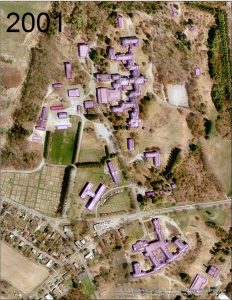
GoogleEarth overview of original Northampton State Hospital campus in 2001 (before demolition in 2002). The purple outlines mark where the original building stood. Courtesy of Megan Mendenhall, ’18.
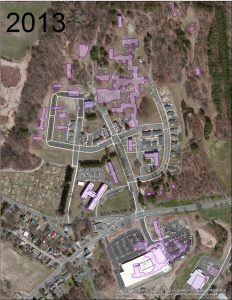
GoogleEarth overview of the former hospital campus in 2013 (after demolition and redevelopment). The purple outlines mark where the original building stood. Courtesy of Megan Mendenhall, ’18.
Based on these projects, largely headed by Historic Northampton and the “Save Old Main” Campaign, the historical narrative suggests that the hospital’s close relationship with Northampton started deteriorating as the facilities and level of patient care began deteriorating in 1910. However, based on the information in the Smith College Archives, Historic Northampton, and the Hampshire Room in Forbes Library, the hospital was far from isolated. The neighboring institutions shared faculty members, allowed students to work and study in the hospital, as well as other connections. While the nature of the relationships between the neighboring communities changed, Smith College and the Northampton State Hospital continued a close relationship well into the mid-1900s. Yet much of this history has been removed from current memorialization projects.
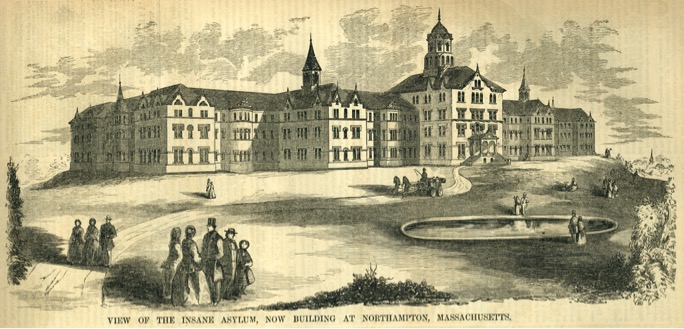
“Old Main” in Ballou’s Pictorial Drawing-Room Companion, August 30,1856“Old Main” in Ballou’s Pictorial Drawing-Room Companion, August 30,1856 (published in Boston). The image was intended as an advertisement depicting community members and patients enjoying the grounds of the hospital campus. Courtesy of Barbara Blumenthal.
Neighboring Institutions:
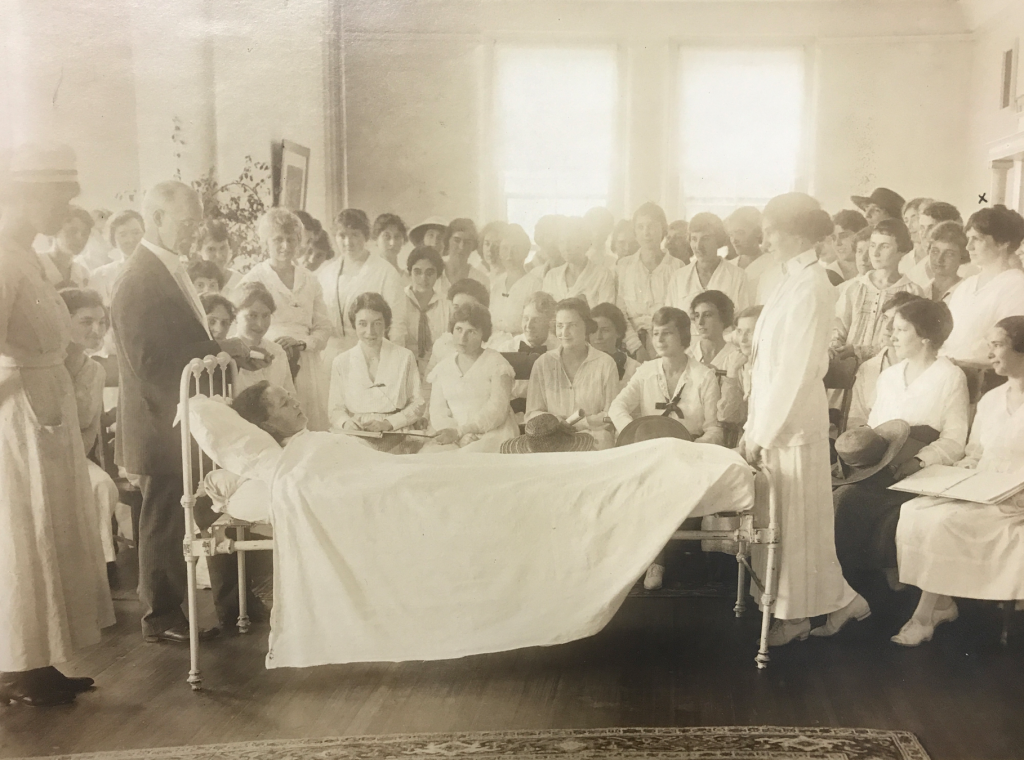
School of Social Work Photo, Summer 1918. Smith College Archives, Graduate Work- School for Social Work Collection.
Within the Smith College Archives, buried in the folders of the Graduate Work -School for Social Work Collection lays a curious photo. Fading and ripped around its aging edges, the image displays thirty young women, all dressed in long white skirts and white-buttoned blouses. Their short hair has been meticulously pinned back behind their ears so that they have an undisrupted view of the details of the event they are furiously scribbling into their notebooks. Their attention is drawn to the center of the room, where a man in a dark suit is leaning over the head of a pale women tucked into a hospital bed. Carefully written in black pen on the reverse side of the photograph is the caption “School for Social Work conducting class in Psychiatry at Northampton State Hospital during 1st session of school in summer of 1918.”[7] Lightly scripted in faded pencil at the bottom of the photo reads “Dr. Houston” and “Dr. Spaulding.”[8] There is a haunting quality to the photo. Dozens of dark eyes are curiously transfixed onto the face of a Northampton State Hospital patient, lying in her hospital bed with her eyes closed. Yet, with their fixed stared and quick notes, the students are eagerly dissecting the patient openly displayed before them.
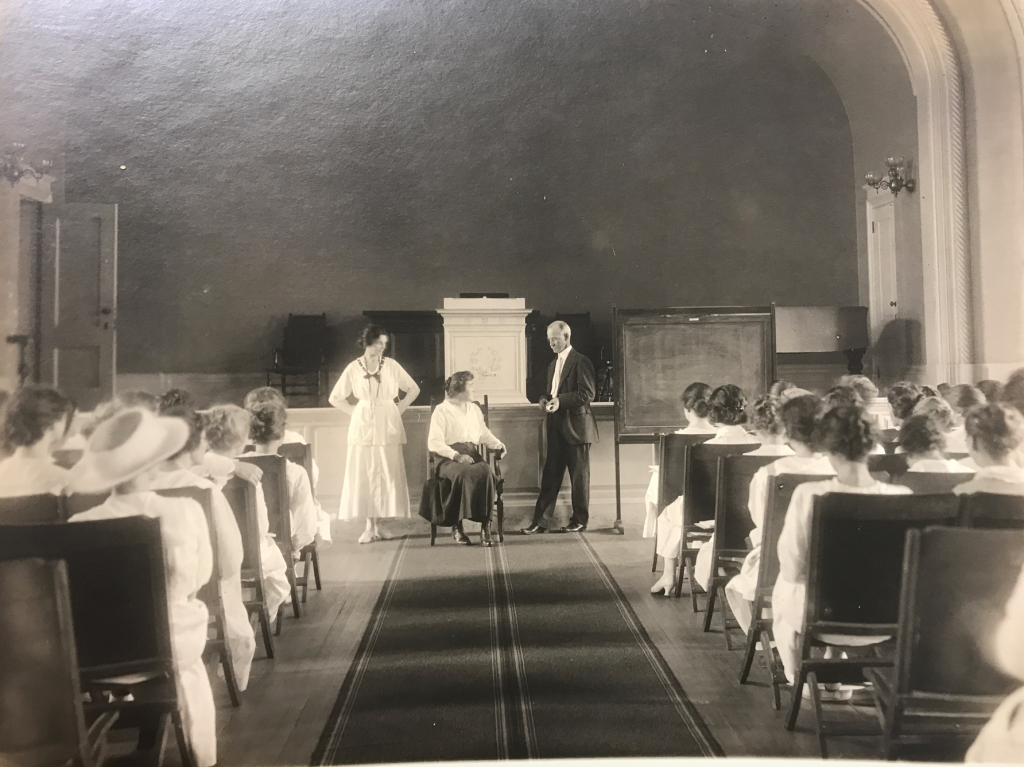
Clinic-School of Social Work Photo, Summer 1919. Smith College Archives, Graduate Work- School for Social Work Collection.
Within the same collection, neatly tucked into a white envelope, sits a second photograph depicting a similarly haunting scene. In a dark lecture hall, Dr. Spaulding, neatly dressed in a black suit stands at the front of the room. Next to him sits a woman in a chair, peering up at his looming face. Behind her, standing at attention is a nurse, dressed in all white hovering close to the back of the chair. Facing them is an entire auditorium of Smith Students, observing the interview. On the back of the photograph is the caption “Dr. Houston questioning a patient at the Northampton State Hospital in a clinic for School for Social Work, 1919.”[9] Looking at these photos as a current Smith student, there are a several questions that are raised: namely, why are Smith students examining and observing hospital patients for clinical practice?
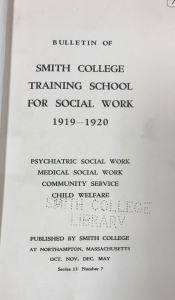
Bulletin of Smith College Training School for Social Work, 1919-1920 (Northampton: Smith College, 1920), Smith College Archives.
Bulletin of Smith College Training School for Social Work, 1919-1920. At Smith College in the early 20th-century, for only $175, selected students could enroll in the Psychiatric Social Work track. Within this course of instruction, students would be taught “groundbreaking methods of training” through a combination of theoretical instruction, practical instruction, and advance study. The program was desiccated to educating young women “upon social aspects of both hygiene and disease,” through a variety of course such as: Psychology, Mental Tests, Sociology, Social Organization, or specialized courses in Social Psychiatry.[10]
The photographs mentioned above, captured snapshots from within Dr. John A. Houston’s 311- Social Psychiatry course. Curiously, the “Bulletin of Smith College Training School for Social Work lists Dr. Houston as not only an instructor at Smith, but additionally the current Superintendent of the Northampton State Hospital.[11] Under the courses of instruction section, Dr. Houston’s course is listed as being assisted by Dr. Edith Spaulding, M.D., a lecturer in Social Psychiatry and the operator of the Laboratory of Social Hygiene.[12] The course was designed to focus on how social factors impact or contribute to mental hygiene or mental disease. It aimed to present a “general view of the governmental, societal, family, and personal significance of psychopathic conditions.”[13] Included in the course’s syllabus are frequent trips to Smith’s neighboring institution, the Northampton State Hospital, for clinical observations. According to the Smith College Bulletin published in 1933, Dr. Houston’s Social Psychiatry class was so popular that it ran with no changes to the syllabus for over 14 years.[14] In a newspaper clipping dated June 9, 1919, a Dr. John Elliot of the Hudson Guild even praised the class stating “the whole community owes a debt to Smith College for having organized its unique training school for social work” that engages with community health institutions. [15]
A Gap in History:
While the relationship between the Smith School of Social Work and the hospital is well documented, there is still further work to be done examining the nature and ethical responsibility associated with this connection. Many of the memorialization projects such as the proposed Walking Tour of Northampton State Hospital and the NHS Memorial Park project are doing important work by memorializing the history of the hospital and the timeline of its redevelopment. However, human experiences have largely been cleansed from these parks and polished historical markers. Due to the fact that the hospital and its patients played such a prominent role in the community, it seems remiss to remove it from Northampton’s public history. This project aims to fill in some gaps by preserving the history of the close relationship between Smith College and Northampton State Hospital. Additionally, by investigating the relationship between these two campuses, it is possible to highlight and preserve previously erased experiences of patients, students, and staff members within the hospital.
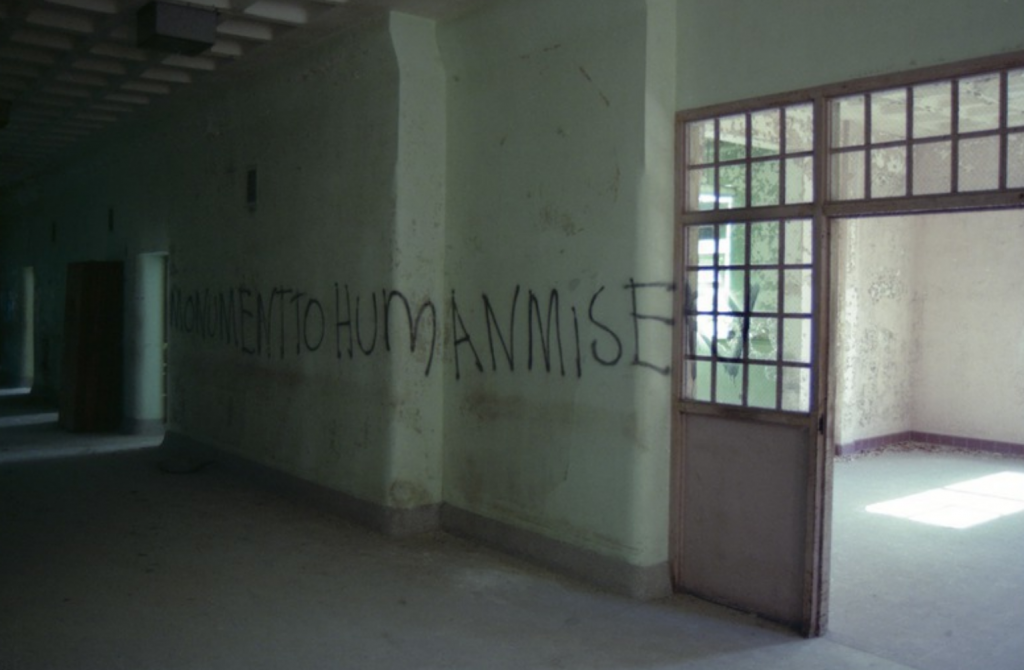
Graffiti on a wall in the doorway of the Northampton State Hospital before demolition, 2001. Mark Majeski, Forbes Library Digital Gallery.
References
[1] Bloomberg, Sanford. 2006, “The history of Northampton State Hospital, 1858-1993,” Florence: Collective Coppies.
[2] Emery, Theo, 1999, “The Rise and Fall of State Hospital,” The Hampshire Gazette, October 12, 1999, Box 3, Folder 1, Northampton and Local History, Smith College Archives, 1.
[3] Bloomberg, Sanford. 2006, “The history of Northampton State Hospital, 1858-1993,” Florence: Collective Coppies.
[4] Emery, Theo, “The Rise and Fall of State Hospital,” 2.
[5] Emery, Theo, “The Rise and Fall of State Hospital,”, 3.
[6] Emery, Theo, “The Rise and Fall of State Hospital,”, 3.
[7] School of Social Work Photo, Summer 1918, Box 1315, Folder Ph, Graduate Work- School for Social Work Collection, Smith College Archives.
[8] Ibid.
[9] Clinic-School of Social Work Photo, Summer 1919, Box 1315, Folder Ph, Graduate Work- School for Social Work Collection, Smith College Archives.
[10] Bulletin of Smith College Training School for Social Work, 1919-1920, Smith College Archives, 12.
[11] Ibid., 4.
[12] Ibid,.4.
[13] Ibid,,11.
[14] Bulletin of Smith College Training School for Social Work, 1931-1932, (Northampton: Smith College, 1932), Smith College Archives, 11.
[15] John Elliot newspaper clipping, 9 June 1919, Box 1314, Folder 1, Graduate Work: School for Social Work, Smith College Archives.
